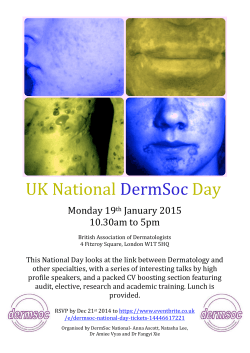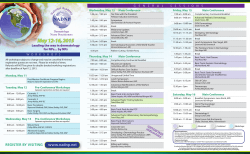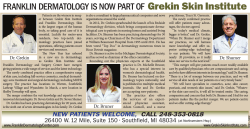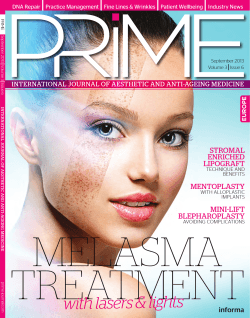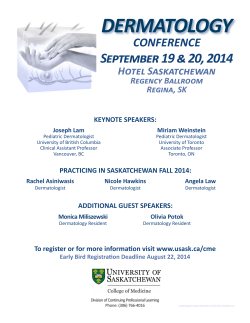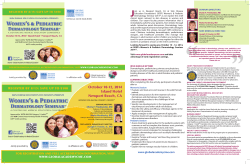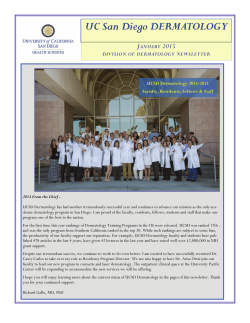
Global Unity in Action at the World Congress of Dermatology
EDITORIAL Global Unity in Action at the World Congress of Dermatology–Vancouver 2015 F rom 5 to 10 August 1889—125 years ago—the First International Congress of Dermatology and Syphilology was convened in Paris, with 210 delegates (Wallach and Tillès, 1992). Since then, 22 World Congresses of Dermatology (WCDs) have taken place, with the next one set for Vancouver, Canada, in June 2015 (Figures 1 and 2, http://www.derm2015. org), where the anticipated attendance will be approximately 50 times that of the first Congress. The WCD is the longest continually running international dermatology meeting, and the founding Congress in Paris actually predates the first modern Olympic Games by seven years. Since 1935, WCDs have been convened under the auspices of the International League of Dermatological Societies (ILDS, http://www.ilds. org), which currently provides global representation for 157 distinct national, regional, and subspecialty organizations. In addition to overseeing the WCD as a quadrennial event, the ILDS acts as a nongovernmental organization with an official relationship with the World Health Organization, and its mission includes fostering cooperation and encouraging worldwide advances in dermatology for the betterment of skin health and patient care. The global commitment of the WCD is embodied in the rotation of the host city among continents, thereby moving beyond its European and US roots (Table 1 lists the sites from 1889 to 2015); the WCD has been hosted in every major continent except Africa. In 1987, the ILDS established a charitable organization, the International Foundation for Dermatology (http://www.ifd.org), whose humanitarian goal is to improve dermatologic care for underserved populations via education and needs assessments. What’s unique about the World Congress? In the previous millennium, the WCD provided a vital opportunity every three to five years for intercontinental communications and networking within dermatology, with the exception of two major Journal of Investigative Dermatology (2014) 134, 2477–2479. doi:10.1038/jid.2014.314 © 2014 The Society for Investigative Dermatology interruptions that coincided with the two World Wars (see Table 1). The WCD thus served as an important venue for the description of new diseases as well as novel treatments. Although modern technology has led to faster and more efficient transfer of knowledge on a global scale, information alone does not necessarily lead to better clinical outcomes. Direct person-to-person interaction remains a fundamental means by which information gains context and relevance for practicing clinicians and scientists. In addition, a critical mass is reached that enables dynamic discussions. The WCD is unique as an international meeting because of the direct official involvement of national and international dermatology societies in selecting the host city and developing the scientific program. Both the scientific and the national host committees are mandated to be broadly inclusive from a global perspective through special session topics, scholarships, and awards. Knowledge transfer is multi faceted and multidirectional. At the WCD, participants from low-income countries learn about the latest advances and therapies, while those from high-income nations learn about challenges in delivering basic skin care to large populations and the compelling need for humanitarian support. With the advent of convenient and less expensive international travel, disorders that were once considered geographically restricted, such as “tropical” infectious diseases, are now seen worldwide. No single nation, region, or continent has a monopoly on best practices or techniques, and the WCD is the largest international dermatology venue where ideas can be shared face to face. During WCD2015, important controversies in dermatology will be explored through a series of thought-provoking debates designed to foster audience participation and interaction. In 1889, dermatologists debated syphilis, the classification of pemphigus, and the “lichen” family of diseases (Wallach and Tillès, 1992), whereas next year the topics for debate will include the role of micrographic surgery and the global impact of highly effective, but relatively expensive, drugs in dermatology. www.jidonline.org 2477 EDITORIAL Figure 1. Official logos of the 2015 World Congress of Dermatology and the International League of Dermatological Societies. The global evolution of dermatology Dermatology is evolving not only in terms of new knowledge and methods but also with respect to the limits and costs of translating these advances into daily clinical practice. Therefore, the WCD2015 program will explore issues related to the use of clinical practice guidelines, global educational standards, information technology, and the optimal use of new treatments and techniques. The scope of dermatologic practice has also shifted dramatically to include broader concepts of skin health and well-being. This is particularly evident when comparing trends in program topics for World Congresses from the latter part of the last century to WCD2015, where aesthetic dermatology will be one of the core disciplines. The scientific program provides a platform for integrating the reality of cosmetic dermatology as well as appreciation of the diverse cultural and ethnic definitions of well-being and appearance throughout the world. Sessions on aesthetic medicine will incorporate and apply knowledge about the scientific bases for photoaging, scarring, and disfigurement as well as technology-based solutions. Another area of dermatology that continues to evolve at a rapid pace is investigative dermatology. Insights into mechanisms of disease, from atopic dermatitis to vitiligo, will be highlighted in several sessions. Because advances in clinical care are just as likely to come from epidemiological methods as from conventional “basic science,” the “science of populations and groups” will be a key topic at WCD2015. Inclusiveness at WCD2015 The inclusiveness of WCD2015 goes well beyond simple geography. The “world” of dermatology also includes allied health professionals, patient-support groups, and advocacy leaders; dermatology agencies and commissions; and industry partners. These groups will all be incorporated into the WCD2015 program. In addition, an entire day has been designated for national and regional dermatology “sister” societies to showcase their activities to a global audience. Two nursing organizations that belong to the ILDS will host scientific and leadership sessions as well. The major goal of WCD2015—or any other meeting of dermatologists—is improvement in patient care. Quality of life is now an essential research and clinical dimension 2478 Journal of Investigative Dermatology (2014), Volume 134 that is becoming an explicit and mandatory standard for day-to-day practice. Discussions on achieving patientfocused care and clinical research are enhanced when patients themselves can be directly involved. Patients with skin disorders have the ultimate vested interest in collectively working toward better support, care, and research for their afflictions. Growing numbers of patient-based groups and organizations have developed over the past decade, especially nationally, and representatives from many of these support groups will be attending WCD2015. The hope is that their proven successes at both the national and regional level can be leveraged to establish an international vision for a variety of skin diseases, akin to the International Federation of Psoriasis Associations. Thus, one specific objective for patient leaders at WCD2015 will be to explore the eventual creation of an international coalition of skin diseases that will work in partnership with the ILDS and dermatologists around the world. Interactions between medical practitioners and industry have justifiably come under greater scrutiny by government regulators and the general public. Nevertheless, it is virtually impossible to practice dermatology without using commercially based products and services. Newer treatments such as “biologics” are more often derived from rigorous and systematic scientific research than from serendipity, and currently only the pharmaceutical industry has the capacity and resources to make these treatments possible within the existing regulatory milieu. Table 1. World Congress of Dermatology Host Cities Year Host city 1889 Paris 1892 Vienna 1896 London 1900 Paris 1904 Berlin 1907 New York 1911 Rome 1930 Copenhagen 1935 Budapest 1952 London 1957 Stockholm 1962 Washington 1967 Munich 1972 Padua and Venice 1977 Mexico City 1982 Tokyo 1987 Berlin 1992 New York 1997 Sydney 2002 Paris 2007 Buenos Aires 2011 Seoul 2015 Vancouver EDITORIAL Supporting the future of dermatology around the world The WCD2015 Scientific Committee is committed to including the young “rising stars” of dermatology as speakers and has asked the session leaders to formally include these individuals in their programs. The goal is for seasoned academicians and experienced clinicians to share speaking responsibilities with emerging experts who are pre-professorial and/or younger than 40 years of age. In this way, WCD2015 will be passing the baton to ensure representation from the next generation of dermatologists. In addition, scholarships targeting residents and fellows, as well as young dermatologists from low-income countries, are being provided by WCD2015, the American Academy of Dermatology, and the International Society of Dermatology, among others. In 2014, as we celebrate the quasquicentennial of the 1889 Parisian WCD, we acknowledge the central role of the WCD in providing a global platform for unifying dermatologists and skin biologists. WCD2015 aims to embrace the broader dermatology family by drawing on the unique expertise and experience of allied health professionals and patient leaders. Beyond the onsite knowledge and camaraderie that WCD2015 will provide, long-term projects made possible by WCD2015 include humanitarian support via the International Foundation for Dermatology, global initiatives by the ILDS to unify dermatology, and international advocacy aimed at governments, commissions, and our medical colleagues. Over the past several years, globalization has profoundly shaped politics, commerce, communications, technology, education, and, of course, medicine. Please join your colleagues in Vancouver in June 2015 at the WCD to bear witness, participate, and contribute to the unifying effects of globalization in dermatology. Figure 2. Vancouver will host the World Congress of Dermatology in June 2015. Courtesy of Tourism Vancouver. Industry-sponsored symposia during WCD2015 will expose participants to the science and promotion of these recent advances. WCD2015 participants can be confident that the ILDS and its organizers will ensure a high level of transparency so that there will be a clear distinction between commerce and clinical education and that evidence-based approaches are incorporated to the greatest extent possible. Harvey Lui, Jerry Shapiro, Wolfram Sterry and Jean Bolognia 23rd World Congress of Dermatology and the International League of Dermatological Societies CONFLICT OF INTEREST HL is a member of the board of the International League of Dermatological Societies (ILDS) and secretary-general of the World Congress of Dermatology (WCD), JS is a member of the board of the ILDS and president of the WCD, WS is president of the ILDS, and JB receives royalties from Elsevier and is a member of the board of the ILDS and chair of the Scientific Committee of the WCD. REFERENCE Wallach D, Tillès G (1992) First International Congress of Dermatology and Syphilology, Paris, Aug. 5–10, 1889. J Am Acad Dermatol 26:995–1001 www.jidonline.org 2479
© Copyright 2025
